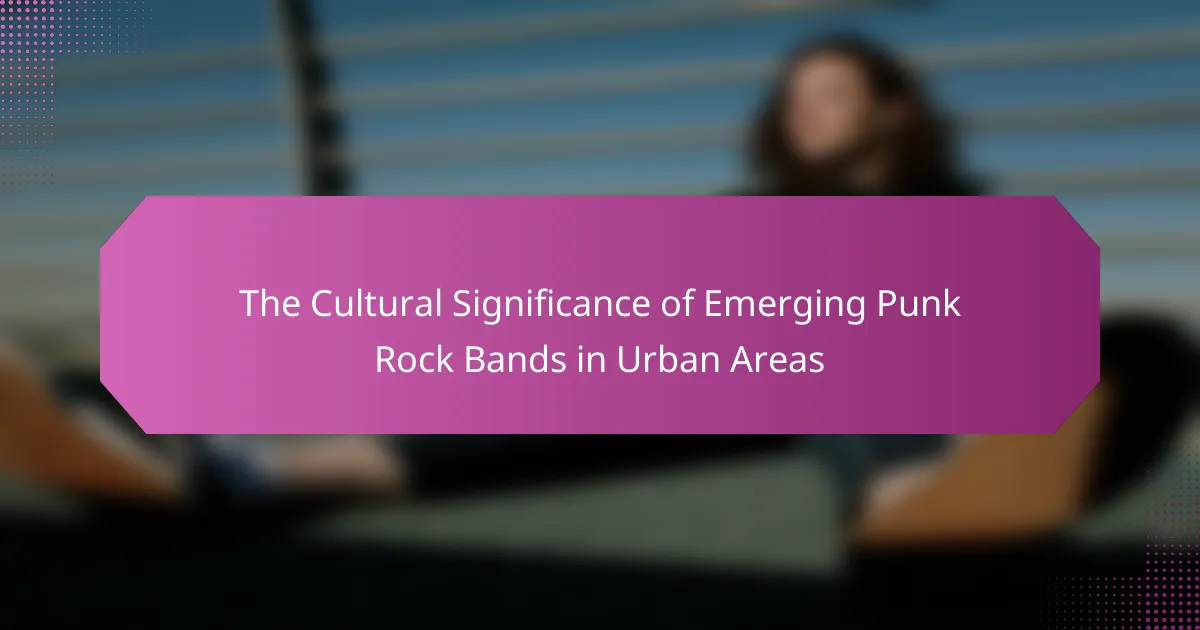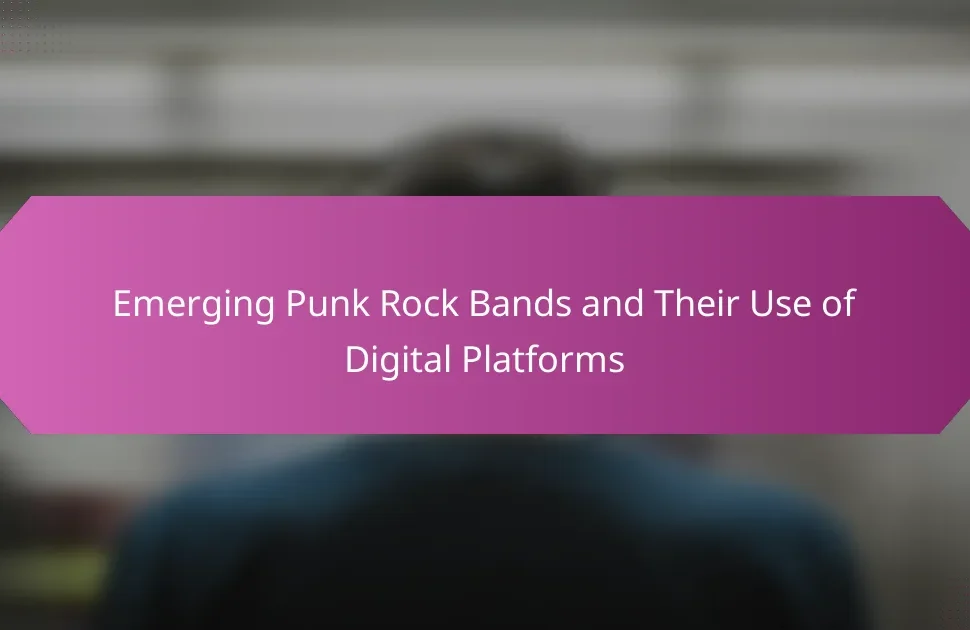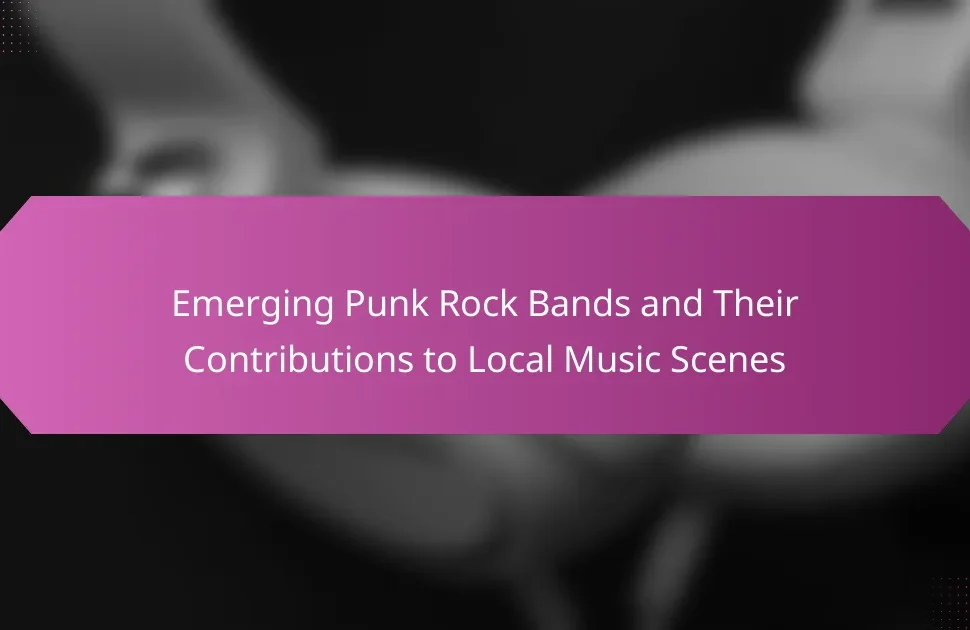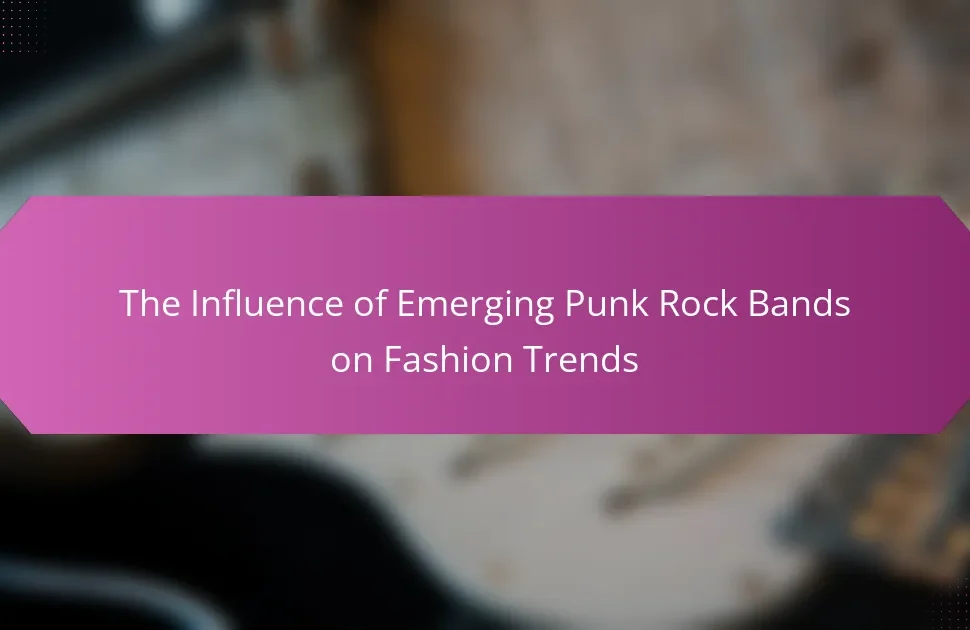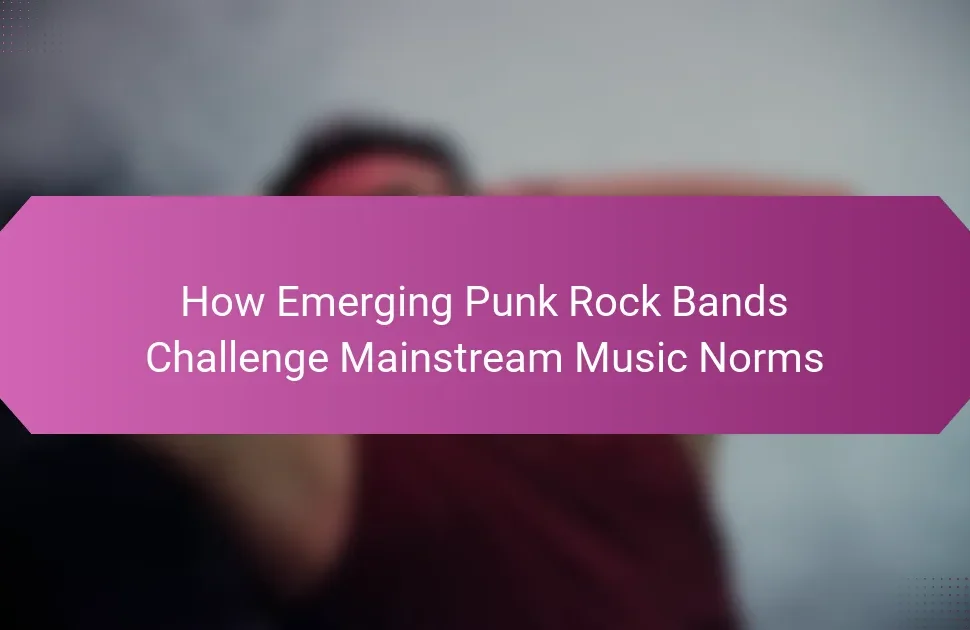Emerging punk rock bands are reshaping urban culture by fostering community and promoting social change. They blend traditional punk with contemporary themes, addressing local issues and resonating with diverse audiences. The support from local communities enhances their visibility and creativity, while festivals provide platforms for artistic expression. Social media plays a crucial role in building loyalty and connecting with fans, highlighting regional variations in the punk rock movement across cities.
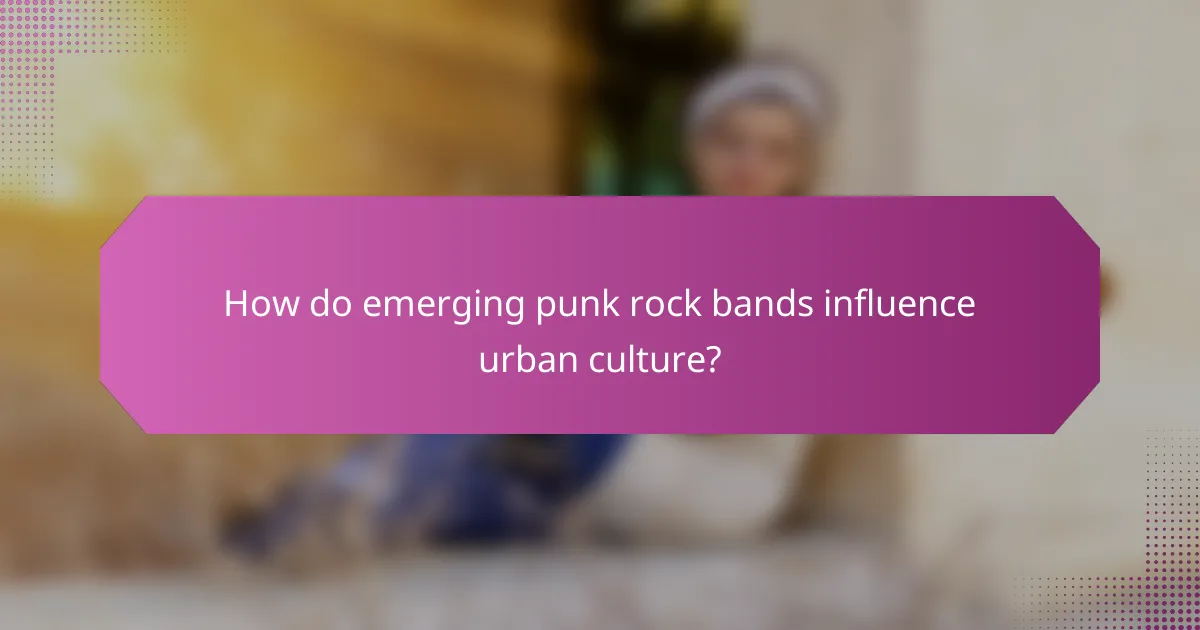
How do emerging punk rock bands influence urban culture?
Emerging punk rock bands significantly influence urban culture by fostering community, promoting social change, and shaping local identities. They create spaces for artistic expression and often challenge societal norms. Their music and events encourage grassroots movements, reflecting the struggles and aspirations of urban youth. As a result, these bands become catalysts for cultural conversations, driving innovation in fashion, art, and lifestyle within their communities.
What are the key characteristics of punk rock music in urban settings?
Punk rock music in urban settings is characterized by its raw energy, DIY ethos, and social commentary. These bands often reflect local issues, fostering community identity and resistance. The genre’s unique attributes include aggressive instrumentation and distinctive fashion styles that resonate with urban youth. Rarely, punk rock incorporates elements from other genres, creating diverse subcultures within cities.
How do these bands reflect socio-political issues in their lyrics?
Emerging punk rock bands often reflect socio-political issues through their lyrics by addressing themes like inequality, injustice, and resistance. These bands serve as a voice for marginalized communities, articulating frustrations with systemic problems. Their lyrics frequently challenge authority and provoke critical thought, resonating with urban youth facing socio-economic struggles. For instance, bands may highlight police brutality or gentrification, making their music a form of activism. This connection between music and social commentary reinforces the cultural significance of punk rock in urban areas.
What role do local venues play in the success of emerging punk rock bands?
Local venues are crucial for the success of emerging punk rock bands by providing essential platforms for exposure and community engagement. These spaces often foster a sense of belonging, allowing bands to connect with local audiences and build a loyal fan base. Venues often host live performances, which serve as a vital income source and a means for bands to showcase their talent. Additionally, they create networking opportunities with other artists, promoters, and industry professionals, enhancing the band’s visibility. The intimate setting of local venues allows for genuine interactions, which are key to cultivating a dedicated following in the punk rock scene.
How do collaborations with other genres shape the punk rock scene?
Collaborations with other genres enrich the punk rock scene by introducing diverse influences and expanding its audience. These partnerships often result in innovative sounds that challenge traditional punk norms. For instance, collaborations with hip-hop artists can infuse rhythmic elements and lyrical depth, attracting new fans. Additionally, cross-genre projects foster community among musicians, encouraging creativity and experimentation. This blending of styles highlights punk rock’s adaptability and relevance in urban culture, making it a dynamic force in contemporary music.

Which emerging punk rock bands are making waves in urban areas?
Emerging punk rock bands like Amyl and the Sniffers, IDLES, and Fontaines D.C. are gaining traction in urban areas. These bands blend traditional punk with contemporary themes, resonating with diverse audiences. Their music often addresses social issues, fostering community and cultural identity. The raw energy and authenticity of these bands attract younger generations, revitalizing the punk scene.
What unique sounds and styles are these bands bringing to the genre?
Emerging punk rock bands are infusing the genre with diverse sounds and styles. They blend traditional punk elements with influences from hip-hop, electronic music, and regional cultural sounds. This fusion creates unique rhythms and lyrical themes that resonate with urban audiences. For instance, bands like Amyl and the Sniffers incorporate garage rock influences, while others emphasize socio-political commentary through their lyrics. These innovations reflect the dynamic cultural landscape of urban areas, making punk rock more relevant and accessible to new generations.
How do the backgrounds of these bands influence their music and message?
The backgrounds of emerging punk rock bands in urban areas significantly shape their music and message. These bands often draw inspiration from their diverse cultural environments, reflecting social issues and local struggles.
Urban settings provide a rich tapestry of experiences, influencing lyrical themes and musical styles. For instance, bands may incorporate elements from various genres prevalent in their communities, creating a unique sound that resonates with their audience.
Additionally, the historical context of punk rock, rooted in rebellion and activism, is often mirrored in the messages these bands convey. They address topics like inequality, identity, and resistance, fostering a sense of community and solidarity among listeners.
Ultimately, the cultural significance of these bands lies in their ability to channel their backgrounds into impactful music that speaks to the realities of urban life.
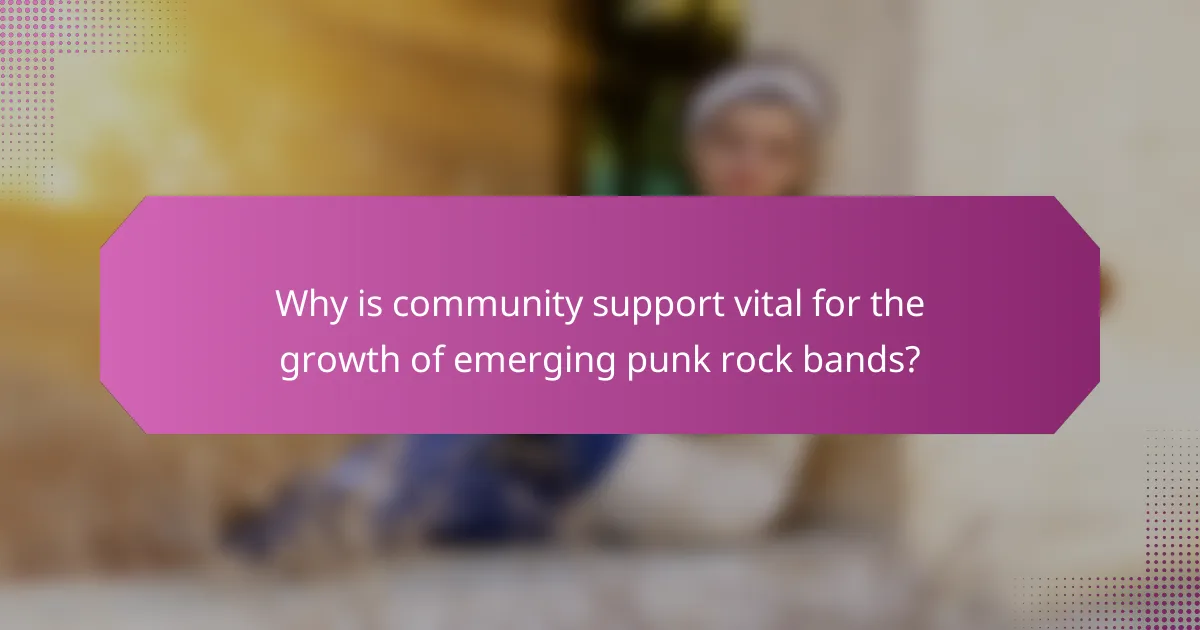
Why is community support vital for the growth of emerging punk rock bands?
Community support is essential for the growth of emerging punk rock bands because it fosters local connections and amplifies their visibility. Strong community ties create a loyal fan base, which is crucial for grassroots promotion. Local venues and events provide platforms for these bands to showcase their talent, leading to increased opportunities. Additionally, community engagement often results in collaborative efforts that can enhance creativity and innovation within the punk rock scene. This support not only sustains the bands but also enriches the cultural landscape of urban areas.
What are the common challenges faced by these bands in urban environments?
Emerging punk rock bands in urban areas face challenges such as limited access to venues, competition for audience attention, and financial constraints. These issues hinder their ability to grow and connect with audiences. Additionally, navigating local regulations can restrict performance opportunities. The unique urban landscape can foster creativity but also presents obstacles in establishing a sustainable presence.
How do grassroots movements help in promoting local punk rock acts?
Grassroots movements significantly enhance the visibility of local punk rock acts by fostering community engagement and support. These movements create platforms for emerging bands, allowing them to perform at local venues and festivals.
By organizing events, grassroots groups cultivate a loyal fan base that appreciates the unique cultural expressions of punk rock. They often promote collaboration among artists, leading to innovative music and stronger community ties.
Moreover, grassroots efforts can help local bands gain media attention, which amplifies their reach beyond the immediate area. This visibility often translates into opportunities for touring and recording, further solidifying the local punk scene’s cultural significance.
Ultimately, grassroots movements empower local punk rock acts, ensuring their voices are heard and their cultural contributions recognized.
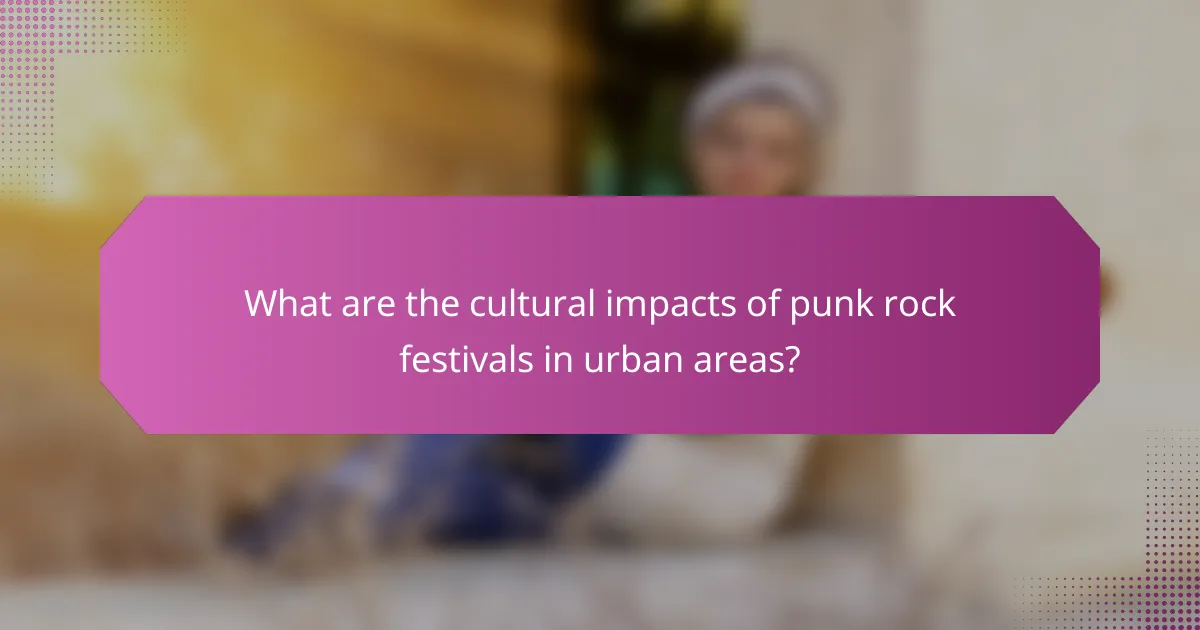
What are the cultural impacts of punk rock festivals in urban areas?
Punk rock festivals significantly influence urban culture by fostering community, promoting artistic expression, and challenging societal norms. They create spaces where diverse voices unite, encouraging local engagement. Festivals often showcase emerging punk rock bands, enhancing their visibility and providing platforms for grassroots movements. The DIY ethic prevalent in punk culture inspires creativity and resilience in urban areas, leading to a vibrant cultural landscape. Furthermore, these festivals can stimulate local economies through increased tourism and commerce, reinforcing their cultural importance.
How do these festivals promote diversity and inclusion within the punk scene?
Festivals promote diversity and inclusion within the punk scene by showcasing a variety of voices and backgrounds. They create safe spaces for marginalized groups, fostering community and collaboration. Additionally, these events often feature diverse lineups, encouraging representation across gender, race, and sexual orientation. This inclusivity enhances the punk culture, making it more vibrant and reflective of urban society.
What economic benefits do punk rock festivals bring to local communities?
Punk rock festivals provide significant economic benefits to local communities. They stimulate local businesses, create jobs, and attract tourism. For example, a festival can increase revenue for hotels, restaurants, and shops. Festivals often generate thousands of attendees, enhancing local visibility and community engagement. Additionally, they can lead to long-term investments in infrastructure, benefiting the area beyond the event.
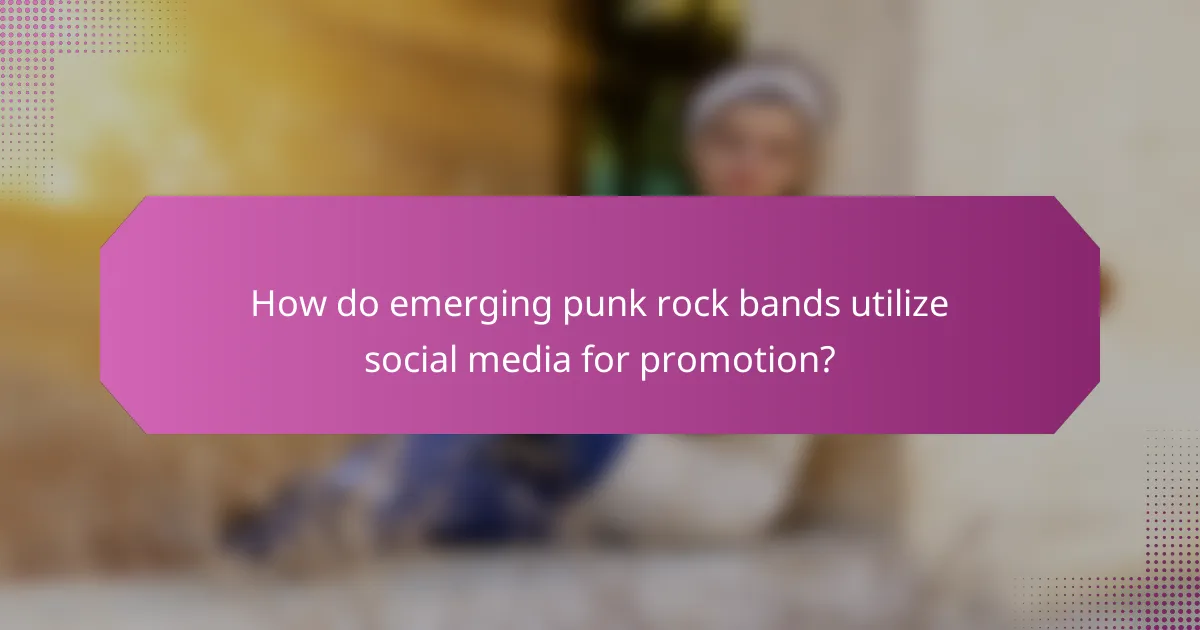
How do emerging punk rock bands utilize social media for promotion?
Emerging punk rock bands leverage social media to enhance their visibility and connect with audiences. They utilize platforms like Instagram, Twitter, and TikTok to share music, promote events, and engage fans directly.
These bands often create visually striking content that reflects the punk aesthetic, which resonates with their target demographic. Engaging storytelling and behind-the-scenes glimpses foster a sense of community.
Moreover, social media allows for real-time feedback, enabling bands to adapt their strategies based on audience reactions. This immediate interaction builds loyalty and encourages grassroots support, essential for success in urban areas.
As a result, social media serves as a vital tool for these bands to cultivate their identity, share their message, and grow their fanbase organically.
What are effective strategies for engaging with fans online?
Engaging with fans online effectively involves authentic interactions, consistent content sharing, and leveraging social media platforms. Emerging punk rock bands can utilize storytelling to connect with their audience, highlighting their cultural significance in urban areas.
Utilizing live streaming sessions allows bands to perform and interact in real-time, creating a sense of community. Regularly posting behind-the-scenes content fosters transparency and invites fans into the creative process.
Encouraging fan-generated content, such as covers or artwork, nurtures loyalty and enhances engagement. Collaborating with local artists or influencers can expand reach and create meaningful connections.
Finally, analyzing engagement metrics helps bands understand their audience better and refine their strategies for deeper connections.
How does social media change the way punk rock is consumed today?
Social media significantly alters how punk rock is consumed today by enhancing accessibility and community engagement. Platforms like Instagram and TikTok allow emerging punk rock bands to share their music and connect with fans instantly. This immediacy fosters a sense of belonging among listeners, as they can interact directly with artists.
Additionally, social media enables bands to promote their events and merchandise without traditional marketing barriers. For instance, a band can reach thousands of potential fans through a single post, reflecting the unique attribute of direct artist-to-fan communication.
Moreover, social media trends influence the music style and visuals of punk rock, leading to a rare blend of genres. This evolution showcases how urban areas are becoming vibrant hubs for diverse musical expressions. Ultimately, social media serves as a critical tool for the cultural significance of emerging punk rock bands in urban settings, reshaping consumption patterns and fan interactions.
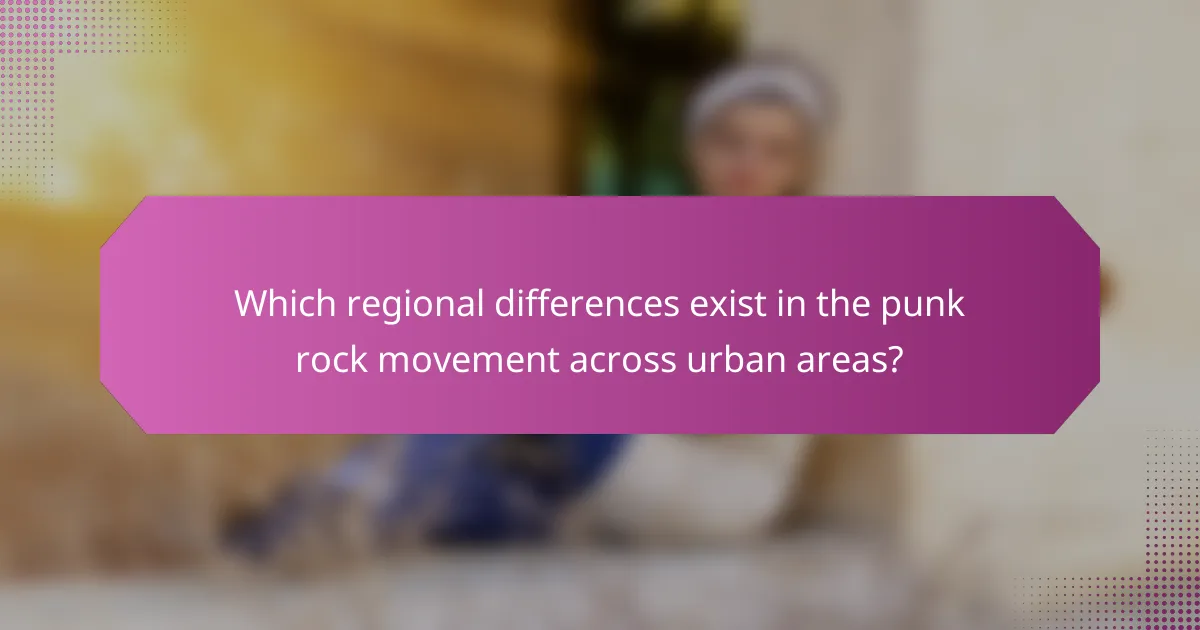
Which regional differences exist in the punk rock movement across urban areas?
Regional differences in the punk rock movement across urban areas highlight diverse cultural expressions. Urban centers like New York and London foster distinct styles, influenced by local social issues and musical heritage. For instance, New York’s punk scene emphasizes DIY ethics and socio-political themes, while London often reflects class struggles and fashion. Cities like Los Angeles introduce a surf and skate culture twist, creating a unique sound. These regional variations enrich the punk rock narrative, showcasing how local contexts shape the genre’s evolution.
How do cultural backgrounds shape the punk rock experience in different cities?
Cultural backgrounds significantly influence the punk rock experience, shaping themes, styles, and community engagement in urban areas. For instance, cities with rich immigrant histories often see punk bands incorporate diverse musical influences and social issues related to their heritage. In contrast, cities with a strong local identity may focus on regional themes, fostering a sense of belonging and resistance.
Punk rock in cities like London emphasizes political activism and social commentary, while in cities like Tokyo, it may reflect unique cultural aesthetics and youth subcultures. The local audience’s values and experiences also determine how punk messages resonate, creating distinct punk scenes.
Additionally, factors such as socioeconomic conditions and historical events can lead to unique punk expressions, showcasing how cultural backgrounds shape the genre’s evolution in different urban environments.
What are some rare influences that distinguish local punk scenes globally?
Local punk scenes are distinguished by unique influences such as regional history, social movements, and local music traditions. These factors shape the identity and sound of emerging punk rock bands. For instance, in Brazil, punk is influenced by tropicalia, blending local rhythms with punk’s raw energy. In Japan, the post-war context has led to a distinct blend of punk with traditional Japanese music. Cultural exchanges also play a role; for example, the global DIY ethic is adapted to local realities. Additionally, the presence of community spaces fosters collaboration among bands, further enriching the scene.
How do emerging punk rock bands adapt to different urban landscapes?
Emerging punk rock bands adapt to urban landscapes by embracing local cultures and responding to community issues. They often reflect the socio-political climate of their surroundings through lyrics and performances. In diverse cities, these bands blend various musical influences, creating unique sounds that resonate with local audiences. Additionally, they utilize grassroots marketing and social media to engage fans and promote shows, building strong community ties. This adaptability enhances their cultural significance, making them vital voices in urban environments.
What best practices can emerging punk rock bands adopt for sustainable growth?
Emerging punk rock bands can adopt several best practices for sustainable growth. Focus on building a strong local community, which enhances fan loyalty and engagement. Collaborate with local artists and venues to create unique experiences that resonate with audiences.
Invest in digital marketing strategies to reach wider audiences while maintaining authenticity. Utilize social media platforms to share behind-the-scenes content and connect with fans directly. Leverage streaming services for music distribution, ensuring accessibility for new listeners.
Regularly engage with fans through live performances and interactive events. This builds a dedicated following and fosters a sense of belonging. Lastly, prioritize quality over quantity in music production, as memorable songs can lead to lasting impact and recognition.
